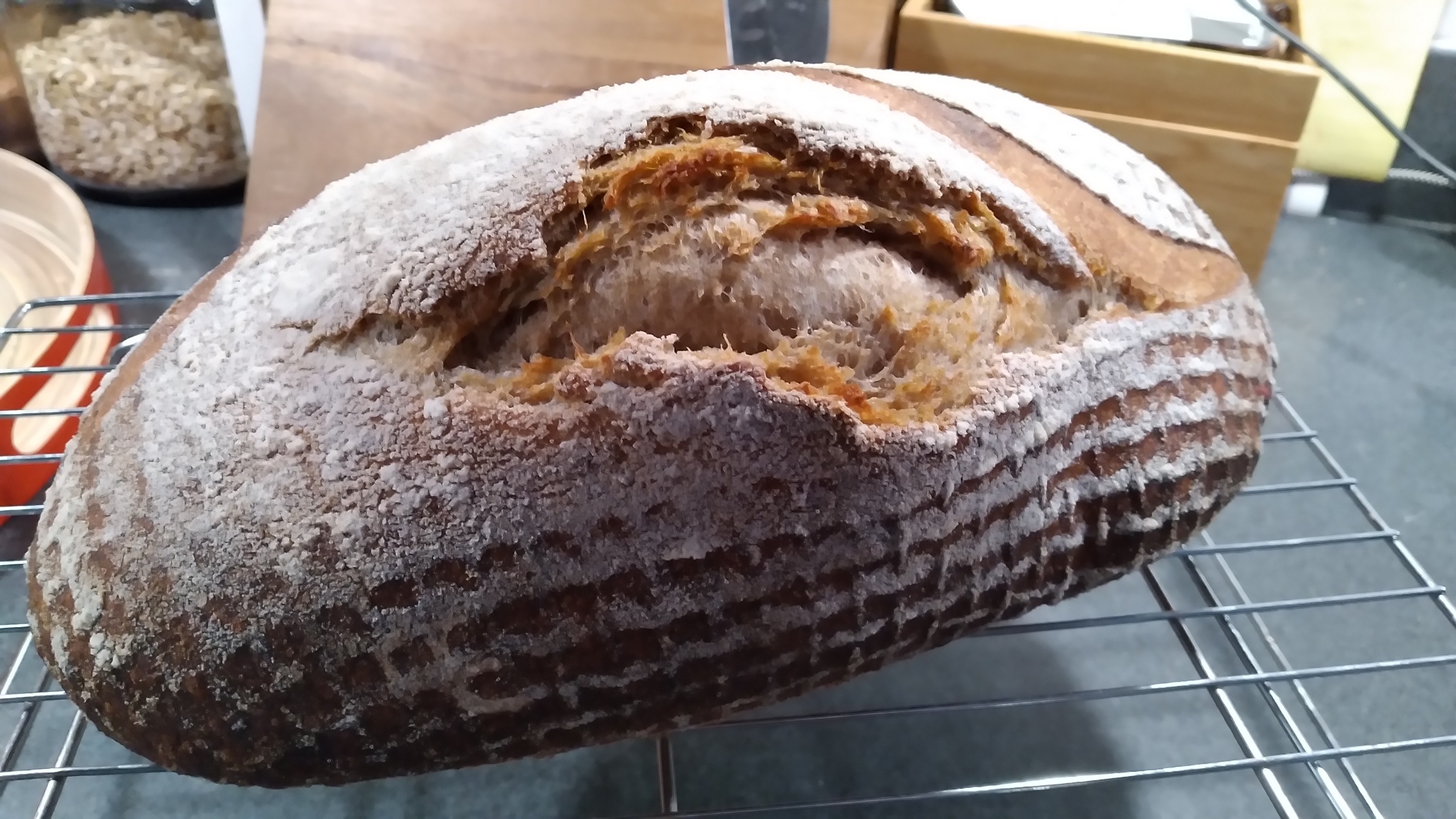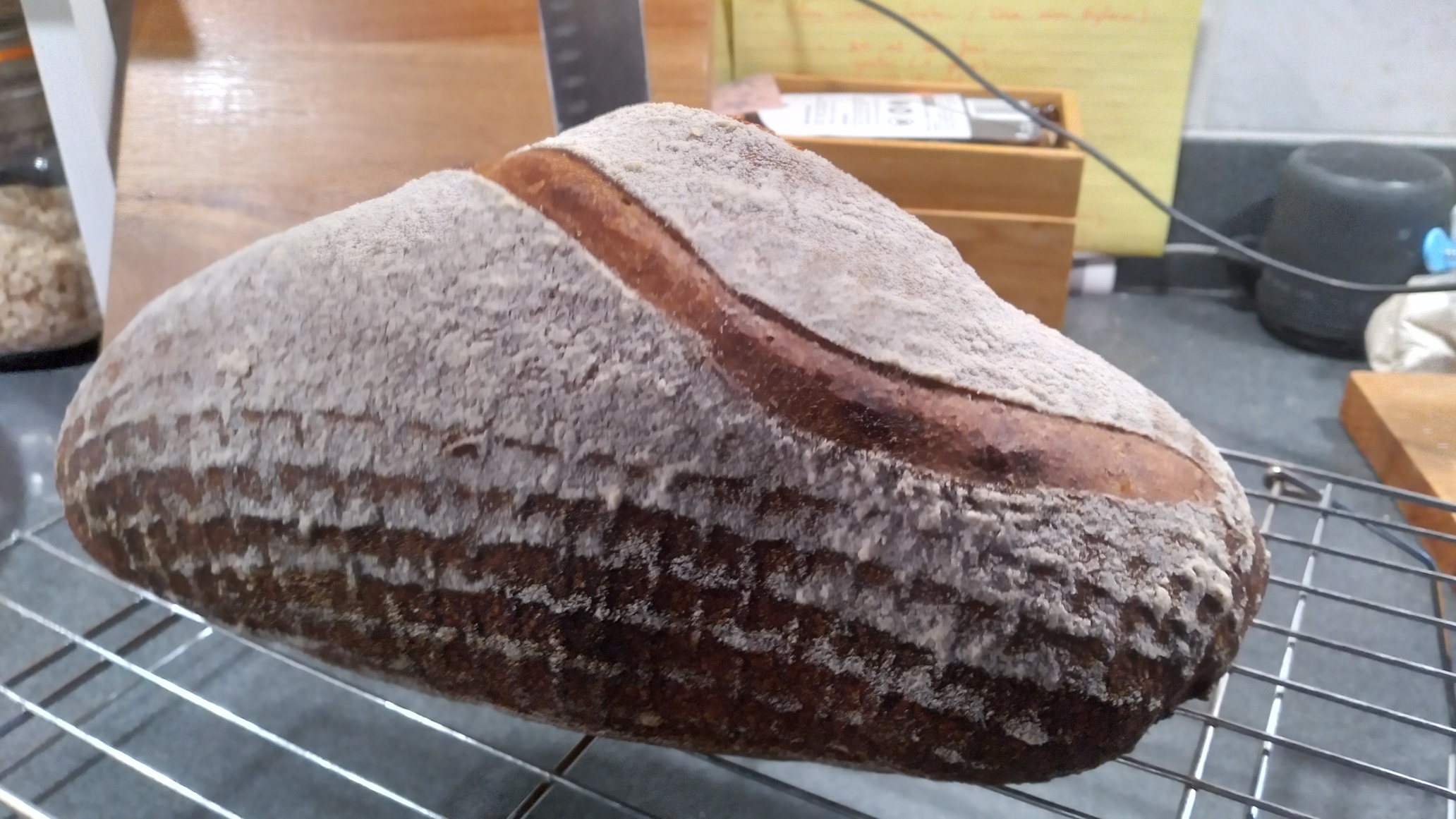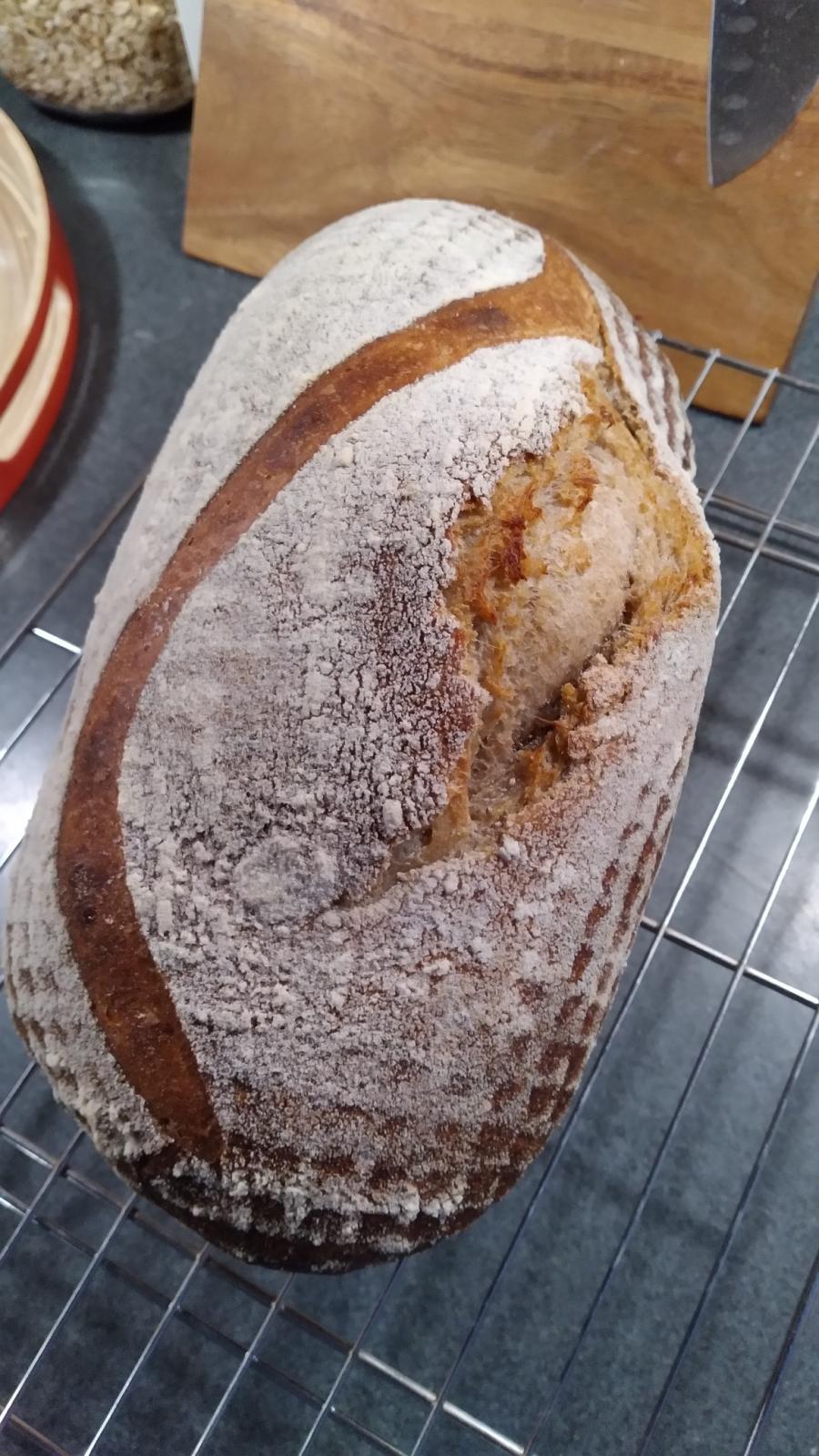Can anybody help me understand the reason of this complete disaster???



I followed my usual protocol except for the baking method: I baked the loaf on a baking stone with lava stones instead of using a Dutch-oven
My guess is that one of the culprits is the steam, or rather lack of steam: it's as if the oven did not retain all the steam I was desperately trying to create...
But there is more to it...Why such a non-existent oven spring except for the weird bump in the middle?? Why did the crumb crack beside the scoring???
Here is what I did:
400g sifted flour T1110 + 100g Whole wheat flour
80% hydration / 20% starter very active
Overnight saltolyse
5h BF at 27°C with 3 sets of S&F then 1 coil fold
Baked at 240° with lava rocks for 20mn then 15mn at 230¯
Thanks in advance!!
Gaëlle
You can't cook a bare (exposed) hearth loaf with the convection fan on, or with top heat.
Both the air currents, which transfer heat quickly (and quickly dry out the moist skin of the loaf), and the upper heating element's ("broiler" in the US, "grill" in the UK) excessive radiant heat (think how sunlight heats exposed things like cars to higher than ambient temp) set the crust too soon. The ears get glued down, and the expanding crumb bursts out from the weakest spot.
So, .... no fan until after oven expansion is complete. Or not at all. When you can turn on the fan, if at all, is determined by trial and error, subject to factors like your formula, the size of the loaf, oven config, etc.
No top heat until the very end, maybe the last minute or two, to "brown up" the crust.
--
If your oven doesn't let you manually set fan on-off, and bottom-heat-only, then you are limited to using an enclosed baking vessel for loaf breads.
Bread baked in a pan (tin), can often survive the fan and top-heat by tenting it with aluminum foil for the most part of the bake.
--
The misunderstanding of how convection ovens differ from conventional ovens is common theme among new bakers. So don't worry, you have plenty of compajy in the matter.
Thanks for your reply!
I did not use the convection mode though, that's why it's so strange...
So you do think it's mainly due to a steam issue and not to being maybe underproofed ???
Here is a crumb shot, in case it could help diagnose this complete flop:
Was the burst on the surface facing down on the stone, or face up away from the stone? Or was the burst on the side of the loaf? This is key to determining if it was a steam issue.
(I don't know if this dough was scored on the side or on the top, so I can't tell where the burst is relative to the stone.)
You said you did not use the fan. Okay, but that's only part. Did the top/upper heating element come on at all? If the upper heating element comes on, even without the fan, before oven spring is complete, that would cause it.
--
edit: Or is it a gas oven? That would do it too. Enclosed baking vessels need to be used for bare hearth breads in a gas oven, or else the loaf skin dries out too fast, like as with an electric convection oven.
the burst was face up away from the stone
The score was on the top of the loaf, where the S shape is on the picture
Regarding the top/upper heating element , I don't really know...All I know is that as I was pouring the water on top of the lava rocks, the steam produced was like vacuumed straight away
I put lots of lava rock on a tray that was placed at the bottom of my oven at the beginning of the pre-heating, then I loaded my loaf and straight afterwards poured around 2 cups of warm water on top of the stones, which produced lots of steam
My oven is an electric one
If it is a gas oven, then steaming is a moot point. Gas home-ovens are vented and can't properly hold steam. And you would need to go back to using a dutch oven.
If it is electric... then... Please describe what you mean by "with lava rocks"? More info is needed as to exactly _how_ you steamed the oven.
Were they in a pan under the stone, or just sitting on the stone next to the bread?
How much water did you put in the pan with the lava rocks?
When did you add water to the pan of lava rocks? at beginning of pre-heat, or when loading the bread?
How much water did you use? What temp was the water, from the tap, warm or boiling ?
All this is key to determining if you used too much or too little steam, or used it correctly.
The tray holding the lava rocks was placed at the bottom of my electric oven, so right underneath the Baking stone
Thank you again so much :-)
Which bottom? Do you mean the bottom (lowest) rack, or on the bottom surface (floor) of the oven?
Was the pan sitting directly on the lower heating element?
Is the lower heating element exposed to view, or is the lower heating element hidden under the floor of the oven?
Sorry for being so picky, but there are many kinds of ovens, so I have to ask. There really are ovens with "hidden" lower heating elements.
--
Upon looking closer at the crumb, the bottom crust is not dark enough. That is an indication of too much steam that cooled the baking stone. So... using only 1 cup of boiling water would be a step in the right direction.
But that is not the only thing going on. There is still a mystery of possible top heat setting the crust.
Edited to add:
How did you set the oven controls? What "mode" did you use?
What is the company name, model name, model # of your oven? I would like to look up the online manual. We need to figure out how to stop the upper heating element from turning on, as I suspect that is also an issue.
If you can't prevent the upper heating element from ever coming on during a bake, then the steam pan needs to go on a rack above the bread so as to shield the bread from the radiant heat of the upper heating element.
Thank you so much for trying to understand what happened!!
So my oven is a Kitchen Aid, but I can't find find the model nb nor the instructions....
The tray with the lava rocks was placed on the floor of the oven
No visible heating element on the oven floor / only the broiler is visible on the top
I used the ''bake'' mode of the oven
If you already have the oven manual, or a link to the online manual, please search it to find out the exact baking operation (that is, which heating elements come on and when, and if the fan automatically comes on) for the baking mode that you select for bread.
In some electric ovens, the upper element still comes on intermittently in "normal bake mode", and in some instances, when the upper element comes on, the fan turns on too, just for the amount of time that the upper element is on.
Added:
The fact that the burst is on the top, and not the side, nor towards the bottom of the loaf, is unusual and mysterious.
We're going to need an expert along the lines of Mini Oven, Mariana, or dmsnyder, to provide further insight.
Added more, again:
Based on the banneton cross-hatch patterns on the loaf, it looks like you did not flip the loaf when going from banneton to baking stone. Is that correct?
Did you also proof with "seam side up" ? So.... my guess is the burst is at the seam which is made when final shaping. If so, the score and the seam need to be on opposite sides of the bread, with seam side down during baking.
But even if that is true, my primary suspicion is that top heat came on, at least intermittently, and possibly the fan came on intermitently too. And this is in addition to too much steam which cooled the oven and especially cooled the stone.
A cool(er) stone means delayed oven spring, and delayed oven spring means the crust sets before oven spring finishes. And hence, when oven spring finally happens, it bursts through the crust at the weakest point... in this case, the seam.
I proofed the dough in a banneton seam side up then flipped the dough seam side down onto the baking stone for baking. The bust happened on the smooth side of the loaf, right next to the S-shaped line that indicates where I scored the dough prior to baking
The cool stone really makes sense now that you point it out....I put quite a lot of water onto the rocks...
I think I'm going to invest into a bigger Dutch oven (the reason why I tried to bake on a baking stone this time is that my actual Dutch oven is a tiny bit too small), that seems to be way more simple!!!
Thank you again so much for your insight Idaveindy I really appreciate it!
I'm pretty sure there is a heating element under what looks to be the floor of the oven. if so, placing a steam pan on the oven floor also interfered with heating the underside of the stone.
To test this out, set your oven to bake mode and preheat at about 220 C. In a minute or two from the start (do not wait until it comes fully up to temp) open the oven door, kneel down and look up to the upper element. Does it seem on? if it does not look on, put your hand near it, do not touch it, just to see if it is giving off heat. Is it giving off some heat?
Then put your hand near, not on, the floor of the oven. Is the floor giving off heat? Are there any holes in or open areas around the "floor plate" through which you see any glowing heating elements?
The answer to these questions will help narrow down what's going on, where heat is supposed to be coming from, etc.
--
Just as a double-check, if you still have this loaf, please check to see if you can identify the seam on the bottom of the loaf. I'm thinking its possible that you lost track of where the seam was. If it was not the seam that burst, then maybe the placement of the steam pan on the oven floor created a cool-spot in the oven.
--
Suggestions for next time:
put the steam pan on the highest possible rack. And place the stone on the highest rack you can that will still allow oven spring/rise without hitting the rack above it. If that's the lowest rack, so be it. And just one cup of near boiling water.
Don't ever let anything rest of the floor-plate of the oven. I think there's a heating element in there.
---
Also realize that once steam gets a bit over 100C it becomes invisible. Just because you don't see misty "wet" steam doesn't mean steam is not there. It becomes what is called "super heated" and is "dry". Superheated dry steam is very dangerous and can cause 3rd degree burns.
Indeed, there,'s a heating element on my Oven's floor...Wow, you're good!!! ;-))
Thank you for guiding me through this super helpful investigation..the only unknown remains the seam as the loaf disappeared too quickly for me to be able to check if it was up or down, but I am pretty sure it was facing down given that I am sure I placed the dough in the baneton seam facing up (I always stitch the dough once in the baneton, so the seam can only be facing up at that stage), so when I flip it over out of the baneton, the seam has to be facing down...but of course I cannot be sure given that there's not a crumb left:-)